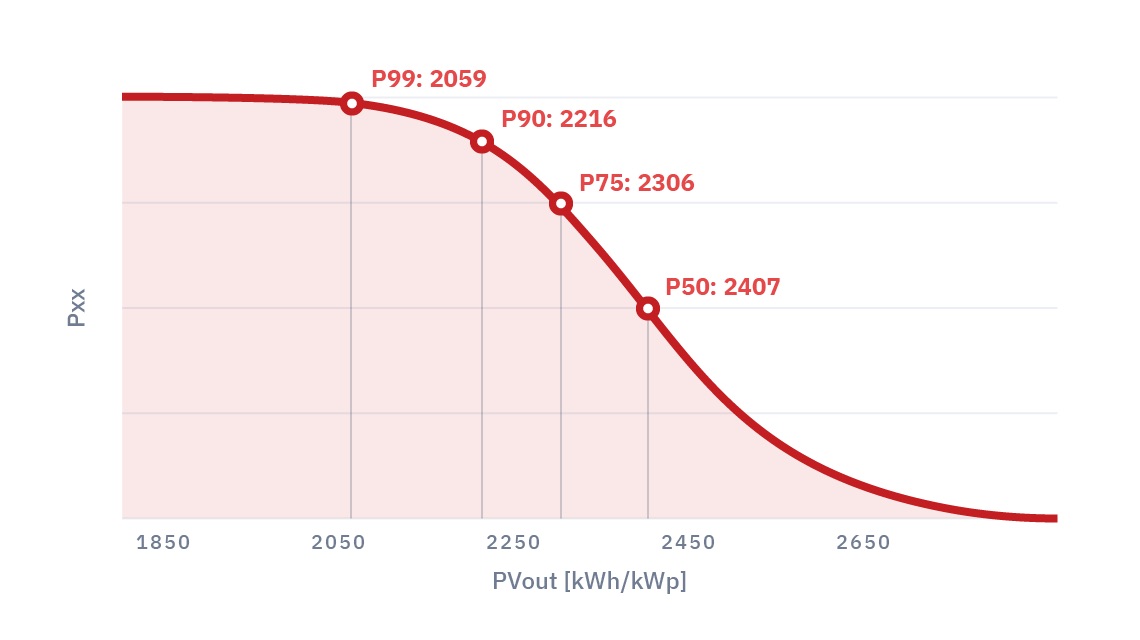





Every energy yield calculation should include a detailed assessment of the range of weather variability at the project site.
For that, you will need a full record of past weather conditions – considering weather trends and extremes. Then you'll understand how the yield calculation models work in the simulation.
This approach will enable you to accurately differentiate between your best- and worst-case scenarios, taking into account energy losses and related uncertainty.

Use a comprehensive history of sub-hourly time series to capture detailed insights on expected production.
Solargis energy yield simulations have been validated across hundreds of real-life projects and through independent academic studies.
They are trusted by financial institutions and investors worldwide, who use Solargis data for tens of thousands of project evaluations each year.
Building a solar power plant requires a multi-million dollar upfront investment.
Developers, investors, and financial institutions are all exposed to financial risk, both at the outset of the project and during its long-term operation. To manage this, they need to reliably evaluate the sustainability of energy generation and calculate the future earnings of the PV plant.
Solargis yield simulation provides all the necessary data and solutions for these evaluations – improving confidence in vital investment decisions.
Combine satellite data with on-site measurements to reduce the uncertainty of estimated energy output and achieve more accurate financial estimates.
The Site Adaptation of Solargis Models service will give you locally enhanced solar and meteo parameters, enabling you to reduce uncertainty of power plant design and energy yield simulations.
For financial risk assessment, investors and developers require reports of expected energy production, including uncertainties, as well as related solar and meteorological data inputs.
We offer an independent and impartial evaluation of PV yield assessment with our proprietary simulation tools and models. These are based on 15+ years of experience working on large and medium-scale PV power plants around the world.
Data-driven insights from our PV Performance Assessment report conducted after months or years of the plant's operation will help you optimize its performance.
The report also provides a revised and more accurate long-term energy yield estimate for refinancing or new asset acquisition purposes.
For larger and utility-scale solar projects, you need long-term solar and meteorological data to be regionally validated with the right uncertainty estimates.
We can provide you with a detailed solar resource validation and assessment report as an add-on alongside standard data delivery.
One of the key challenges for solar project financiers is to assess the expected energy production and revenue of a project over its lifetime, considering the uncertainties and fluctuations of the solar resource.
One of the most critical outputs from PV simulations is the P50 annual energy yield estimate. Often referred to as the "best estimate," the P50 value represents the annual energy yield that has a 50% probability of being exceeded (with an equal 50% chance that the actual yield will fall below it).
However, relying solely on the P50 value may be too optimistic for project stakeholders. To address this, additional probability-based yield estimates are commonly used e.g. P90 value, which indicates the energy yield expected to be exceeded 90% of the time.
Storing and dispatching power at the optimal time requires an extremely granular understanding of how much power a project is generating both now and in the immediate future. Developers, operators, and owners increasingly require high-frequency (1-minute) weather and solar irradiance data that enables them to make quick, accurate and financially effective decisions.
Projects supported by our bankable solar & meteo data, software, and services every year
Years of experience with solar projects and improving industry standards
Coverage of the world’s population with 30 years of solar and meteorological data





